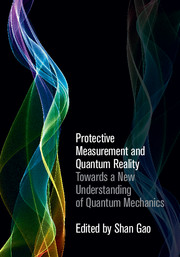Book contents
- Frontmatter
- Dedication
- Contents
- List of Contributors
- Preface
- Acknowledgements
- 1 Protective measurement: an introduction
- Part I Fundamentals and applications
- Part II Meanings and implications
- 7 Measurement and metaphysics
- 8 Protective measurement and the explanatory gambit
- 9 Realism and instrumentalism about the wave function: how should we choose?
- 10 Protective measurement and the PBR theorem
- 11 The roads not taken: empty waves, wave function collapse and protective measurement in quantum theory
- 12 Implications of protective measurement on de Broglie–Bohm trajectories
- 13 Entanglement, scaling, and the meaning of the wave function in protective measurement
- 14 Protective measurement and the nature of the wave function within the primitive ontology approach
- 15 Reality and meaning of the wave function
- Index
- References
10 - Protective measurement and the PBR theorem
from Part II - Meanings and implications
Published online by Cambridge University Press: 05 January 2015
- Frontmatter
- Dedication
- Contents
- List of Contributors
- Preface
- Acknowledgements
- 1 Protective measurement: an introduction
- Part I Fundamentals and applications
- Part II Meanings and implications
- 7 Measurement and metaphysics
- 8 Protective measurement and the explanatory gambit
- 9 Realism and instrumentalism about the wave function: how should we choose?
- 10 Protective measurement and the PBR theorem
- 11 The roads not taken: empty waves, wave function collapse and protective measurement in quantum theory
- 12 Implications of protective measurement on de Broglie–Bohm trajectories
- 13 Entanglement, scaling, and the meaning of the wave function in protective measurement
- 14 Protective measurement and the nature of the wave function within the primitive ontology approach
- 15 Reality and meaning of the wave function
- Index
- References
Summary
Protective measurements illustrate how Yakir Aharonov's fundamental insights into quantum theory yield new experimental paradigms that allow us to test quantum mechanics in ways that were not possible before. As for quantum theory itself, protective measurements demonstrate that a quantum state describes a single system, not only an ensemble of systems, and reveal a rich ontology in the quantum state of a single system. We discuss in what sense protective measurements anticipate the theorem of Pusey, Barrett, and Rudolph (PBR), stating that, if quantum predictions are correct, then two distinct quantum states cannot represent the same physical reality.
Introduction
Although protective measurements [1, 2] are a new tool for quantum theory and experiment, they have yet to find their way into the laboratory; also theorists have not put them to best use, beyond a 1993 paper by Anandan on “Protective measurement and quantum reality” [3]. In Section 10.2, we point out that protective measurements offer new experimental tests of quantum mechanics, and we review recent experiments attempting to measure quantum wave functions. In Section 10.3, we present the Pusey–Barrett–Rudolph (PBR) theorem and discuss their conclusion that the quantum state represents physical reality, and in Section 10.4, we discuss in what sense protective measurements anticipate this conclusion.
Protective measurement: implications for experiment and theory
In 1926, Schrödinger postulated his equation for “material waves” in analogy with light waves: paths of material particles – which obey the principle of least action – are an approximation to material waves, just as rays of light – which obey the principle of least time – are an approximation to light waves [4]. But Born soon discarded “the physical pictures of Schr00F6;dinger” [5] and gave the “material wave” Ψ(x, t) a new interpretation: |Ψ(x, t)|2 is the probability density to find a particle at x at time t. Even Schrödinger was obliged to accept Born's interpretation.
- Type
- Chapter
- Information
- Protective Measurement and Quantum RealityTowards a New Understanding of Quantum Mechanics, pp. 135 - 144Publisher: Cambridge University PressPrint publication year: 2015
References
- 2
- Cited by



